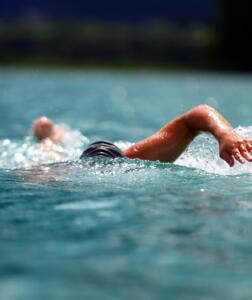Swimming is a great form of recreation, as well as an excellent way to stay in shape.
Learning these competitive swimming techniques can make you a better, more confident swimmer, which in turn makes for a safer day on the lake for you and your family!
 Front Crawl
Front Crawl
In order to perform the front crawl you will need to have your face in the water.
It is important that you keep your legs very close together. This will keep your body in a straight line, which will benefit your shallow and long kicks.
After you have your hand in the water and stretched out, move it slightly out, and then pull it down below the shoulders and the elbow.
Next, press your hand towards the feet with your fingers, and follow a path down the middle of the chest and the stomach.
Then you will get your hand back to the starting position. Remember to take your elbow out of the water first as you move your arms.
In order to keep breathing, you will take a deep breath when you turn your face to the side. Exhale by blowing in the water when your face is in the water.
It will take plenty of practice to perfect this technique, but it is the fastest swimming method.
Backstroke
When performing the backstroke, it is crucial that you have a strong and steady kick. Out of the strokes that are used, the backstroke will require the most vigorous and continuous kicks.
Continuous leg motion is required. You will need to use gentle steady motions. If you stop kicking, the lower half of your body will sink.
When you are kicking you will need to keep your ankle flexible during the flutters of the kicks.
In order to make this easier, do ankle stretches everyday. While you are kicking, make sure that you bend your knees. They should be bent naturally during the technique.
You will need to begin by creating a downward circular motion through the water with one of your arms, rotating it until it reaches back to you side. Repeat motion with your other arm.
Your small finger should enter the water first with the palm facing outwards.
Bend the elbow slightly as you draw it through the pool. The arms should alternate, one coming out as the other is going in.
Butterfly
The arm movements of this stroke are performed in three steps.
You will begin with your arms above your head at shoulder width apart. Pull your hands in towards your body with the palms facing out.
Remember to keep the elbows higher that your hands. This is called “the pull.”
The next step is “the push,” during which you push your palms back through the water, running them along the sides and past the hips.
The last movement is called “the recovery.”
This is where the hands will be positioned as if they are in motion while you are finishing the pull and are getting ready to do another stroke.
Essentially the hands will reach the thighs.
Breaststroke
Position yourself laterally in the water with the arms extended very straight in front of you and your legs in the back of you.
Push your arms apart in order to create a diagonal with the body. Make sure that the palms are facing outward and your elbows straight.
Pull your elbows into the sides of the body, and then bring the hands together in the front of the chest.
You will lift your head, your neck, and your upper chest out of the water in order to breathe.
Bend your knees and your feet toward your bottom. Make a circular motion with the feet until they meet with the legs fully extended.

